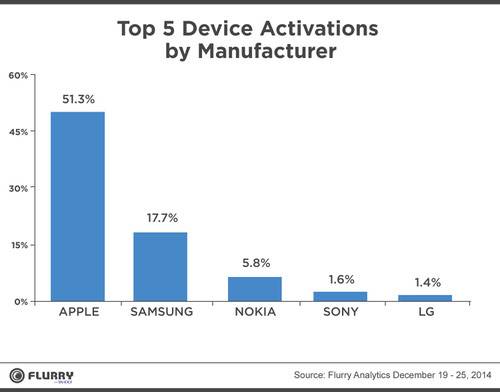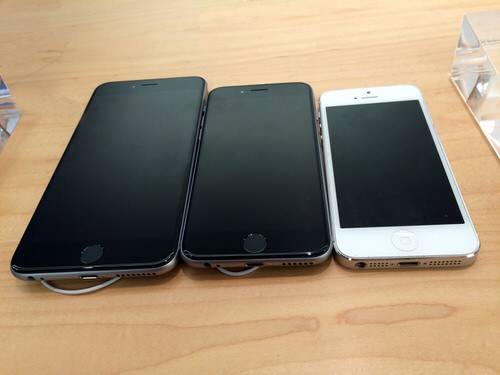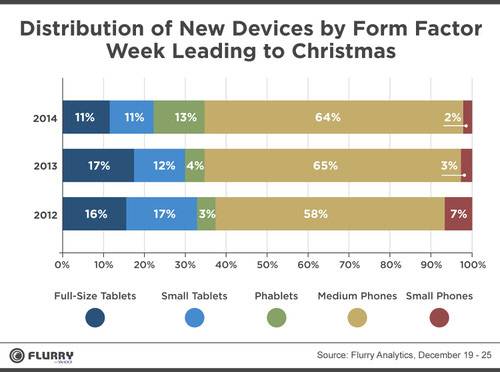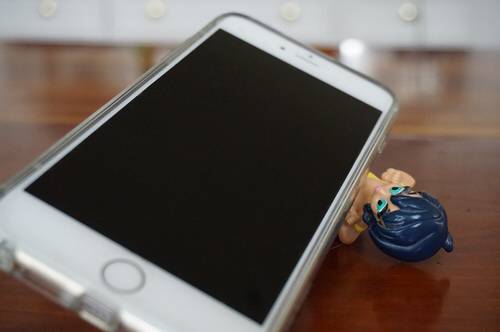ReadWritePredict is a look ahead at the technology trends and companies that will shape the coming year.
According to a report released Monday from analytics firm Flurry, people went nuts for phablets in general—and Apple’s gizmos in particular—over the holiday season.
The report revealed that more than half of new devices activated over Christmas week belonged to Apple, at 51%, while Samsung and Nokia nabbed just 18% and 6%, respectively. Flurry also noted that the trend toward large “phablet” phones heated up, from 3% of devices two years ago to 13% this year.
See also: The Top 5 Smartphones Of 2014
On the surface, the numbers seem to indicate consumers’ growing obsession for phablets. But it’s a backward look that only tells half the story. To understand what that breakdown means and how it may affect the upcoming year in mobile, you have to take into account a few other details.
A Huge Fish In A Shrinking Pond

“For every Samsung devices [sic] that was activated, Apple activated 2.9 devices,” Flurry wrote. “For every Microsoft Lumia device activated, Apple activated 8.8 devices.” The firm also states that Christmas 2014 “saw a big jump in the number of phablets activated.”
That’s a notable outcome in a holiday season that saw “flat” electronics sales overall. According to MasterCard’s holiday spending report, consumer sentiment is shifting away from buying goods to purchasing “experiences.” Any gadget that can stand out in such a dull retail environment must offer something consumers really want—like a huge screen.
This year marks Apple’s entry into the phablet market, so it’s tempting to chalk up the company’s success to finally satisfying people’s voracious appetite for massive phones. But there’s an inconvenient stumbling block to that narrative: Consumers barely had any other choice.
See also: Mastering Apple’s Gigantic iPhone 6 Plus With Puny Hands
You can actually count the number of decent small phones with one hand.
The following are five compact smartphones, perhaps the best of the lot, and all of them pale in comparison to their larger siblings. Yet, not even these offer a display smaller than 4.3 inches:
- LG G2 Mini: 4.7 inch display
- Samsung Galaxy S5 Mini: 4.5 inch display
- HTC One Mini: 4.5 inch display
- Sony Xperia Z1 Compact: 4.3 inch display
- Sony Xperia Z3 Compact: 4.6 inch display
Some believe even smaller 4-inch screens are already dead. This year, the demise of Apple’s last 3.5-inch screen put the iPhones 5S and 5C next on the chopping block. But that says less about public sentiment than mobile makers intentionally killing off or shortchanging compact phones as they foist colossal devices at consumers.

Next year, things may be different. Reportedly Apple may go back to compact 4-inch displays with an “iPhone 6S Mini.” The fact that there’s even a rumor of Apple harking back to a more diminutive size suggests there’s plenty of desire left for wee devices. If the story pans out, the move might even set off a race back to petite phones.
Power Plays, Big And Small

Of course, some people will cling to phablets, no matter what. Like me. For years, I held out for an advanced compact smartphone, but the iPhone 6 Plus changed my mind.
Part of the reason was the luxurious feel of a bigger screen. This year, our time spent on mobile displays finally eclipsed television, making for another trend that shows no sign of slowing. Watching videos on a larger phone display has obvious appeal.
But that wasn’t the real reason.
The iPhone 6 Plus and Samsung Galaxy Note 4 offer battery life that dwarfs their smaller versions. Logically, bigger phones hold bigger power cells. So if Apple unleashes a small iPhone next year, it would have to solve that challenge (or hope that battery technology finally surges forward). Software optimizations help, but they’re no more than workarounds for lackluster lithium-ion cells.
Not Everyone’s Flipping For Phablets

Likely next year, the mobile conversation will shift away from who’s launching a big phone to the other big initiatives they support, like wearables, mobile advertising, mobile payments, real-world services and smart cars, TVs and homes.
See also: 2015: The Year Of The Mobile Singularity
For the devices themselves, what’s left will revolve around battery life and technologies designed to mitigate the annoyance, including fast-charging features and stop-gap solutions like wireless charging and energy management optimizations. Expect these to become even more important talking points in 2015.
Also, if an advanced small Apple iPhone really is on the menu next year, then industry watchers will be glued to those numbers even more than usual. Because if someone can make a compact smartphone that’s operable with a single hand and doesn’t force compromises on users, it could undercut sales of big mobile devices.
Consider that, during the year of the phablet, another wacky trend emerged that goes directly against the “everyone wants massive phones” narrative.
The fashion industry—an influential voice in technology now, thanks in part to collaborations with wearable device makers—seems to have rejected phablets. So what exactly are arbiters of taste like Vogue’s Anna Wintour, celebrity fashionistas like Rihanna and flamboyant rock stars like Iggy Pop rocking these days? Devices that are the very antithesis of huge touchscreens.

Yes, I’m here to tell you that flip phones are apparently back in style. Tell all your phablet-hating friends.
Lead photo by Hadrian courtesy of Shutterstock; iPhone photos by Adriana Lee for ReadWrite; screen shot from YouTube video by Entertainment Tonight; charts courtesy of Flurry.









